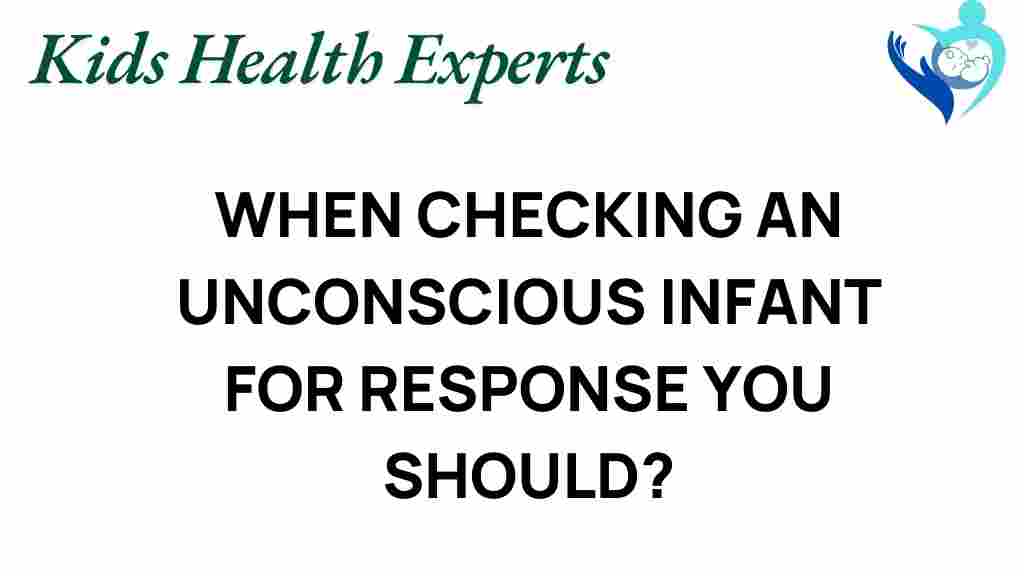Unconscious Infant: Critical Steps in First Aid and Emergency Procedures
As a parent or caregiver, nothing is more distressing than discovering that an infant is unconscious. The initial response is crucial, and knowing how to react can mean the difference between life and death. This comprehensive guide will uncover the critical steps to check an unconscious infant’s response, focusing on first aid, child emergency measures, and effective parental guidance in health safety.
Understanding the Unconscious Infant
An unconscious infant is one who does not respond to stimuli such as sounds, touch, or movement. This state can be alarming and may result from various causes, including:
- Injury
- Choking
- Infections
- Seizures
- Medical conditions (e.g., diabetes, heart problems)
Recognizing the signs of an unconscious infant is vital for timely medical response and effective infant care. Always remember that immediate action is essential.
Essential First Aid Steps for an Unconscious Infant
When faced with an unconscious infant, follow these critical first aid steps:
1. Assess the Situation
Before approaching the infant, ensure the environment is safe. Look for potential hazards that could threaten your safety or the infant’s well-being.
2. Check for Responsiveness
Gently stimulate the infant by:
- Calling their name or making a loud noise.
- Gently tapping their foot or shoulder.
- Observing for any movement or vocalization.
If the infant does not respond, proceed to the next step.
3. Call for Help
Immediately call emergency services or have someone else do so. Ensure that you provide clear information about the situation, including:
- Your location
- The infant’s age and condition
- Any known medical history
4. Check Breathing
Look for signs of breathing by:
- Watching for chest movement.
- Listening for breath sounds.
- Feeling for breath on your cheek.
If the infant is not breathing, initiate CPR immediately.
5. Administer CPR
For infants, CPR involves a specific technique:
- Place the infant on a firm, flat surface.
- Use two fingers placed just below the nipple line to compress the chest.
- Compress the chest at a depth of about 1.5 inches, at a rate of 100-120 compressions per minute.
- After every 30 compressions, give 2 gentle breaths by sealing your mouth over the infant’s mouth and nose.
Continue this cycle until emergency help arrives or the infant shows signs of responsiveness.
Troubleshooting Tips for Parents and Caregivers
In an emergency, it is normal to feel panic and confusion. Here are some troubleshooting tips to help guide your actions:
- Stay Calm: Take a deep breath. Your calmness will help you think clearly and act effectively.
- Follow the Steps: Stick to the steps outlined above. Each action is critical in providing effective care.
- Ask for Help: If you are alone, don’t hesitate to yell for help. Bystanders can assist in calling for emergency services.
- Stay with the Infant: Do not leave the infant unattended, even for a moment.
Preparing for Emergencies: Health Safety for Infants
Preventative measures can greatly enhance health safety for infants. Consider the following strategies:
- Learn First Aid: Take a certified first aid and CPR course focused on infants. Knowledge is empowering.
- Childproof Your Home: Ensure that your environment is safe and free from choking hazards, sharp objects, and toxic substances.
- Keep Emergency Numbers Handy: Have a list of emergency contacts, including pediatricians and poison control, visible in your home.
- Regular Check-ups: Schedule and attend regular health check-ups to monitor your infant’s development and health status.
Conclusion: The Importance of Parental Guidance in Emergencies
In moments of crisis, knowing how to check an unconscious infant’s response can save a life. By following the steps outlined in this article, you can ensure that you are prepared to act swiftly and effectively in the event of an emergency. Remember, proper training in first aid and child emergency measures can enhance your confidence and ability to respond appropriately.
For further information on infant care and health safety, consider visiting this resource for comprehensive guidance. Additionally, exploring first aid courses can arm you with the necessary skills to handle emergencies with confidence.
Being a parent is a journey filled with joy and challenges. Equip yourself with knowledge and stay prepared for any situation, ensuring the safety and well-being of your little ones.
This article is in the category Care and created by KidsHealthExperts Team
